Stay in the know on all smart updates of your favorite topics.
Are you interested in the experiences of others working in smart city projects and organizations? The Smart City Academy provides available knowledge about smart city projects and can help you with project development. This Smart City Academy page provides you with information and researches about the impact and conditions of smart city projects. Professors, teachers and students study the initiation, management, collaboration and scaling of smart city projects and would like to share these results with you. They do so by organizing events and masterclasses, by developing smart city tools and methodologies and by making research and outcomes accessible. You can find everything here. And the good news is.... You can add your knowledge too! Are you working on Smart City research? Please feel free to share your knowledge in the Academy section, under ‘Other research and theses’. The Smart City Academy is powered by the Amsterdam University of Applied Sciences. If you have any questions, you can contact smartcityacademy@hva.nl
Contact with civilians
This week a joined a challenge of the government of Haarlem. The challenge is how we can improve the contact with civilians. See https://r2.miraheze.org/wiki/Contact_met_inwoners for more info.
Looking for: Digital City Experts for Inscience Festival
NEMO Kennislink verzorgt dit jaar een NEMO City Lab evenement tijdens het Inscience festival in Nijmegen. https://www.insciencefestival.nl/. Jaarthema van Inscience 2018 is AI. Inscience is een kwalitatief hoogstaand festival met (inter) nationale gasten en sprekers.
We zoeken experts - bij voorkeur op het gebied van AI in de stad – die willen deelnemen in onze activiteiten. Dat kan zijn als spreker in onze mini colleges of expert bij verschillende interactieve discussie formats. NEMO City Lab is laagdrempelig, speels en gericht op het betrekken van burgers bij stedelijke vraagstukken.
Inscience 2017 aftermovie https://www.youtube.com/watch?v=EBEhnDOjtss
Wat we vragen
Je gaat als expert onder begeleiding van ons team met bezoekers van het festival in gesprek over AI in de stad. Dat gebeurt op zaterdag 10 en zondag 11 november. Het programma duurt 4 uur en loopt naar verwachting van van 12 – 16 uur. Je bent niet 4 uur continue bezig, er is voldoende ruimte voor pauzes.
Wat we bieden
Wij voorzien je van lunch, koffie en thee. Je krijgt een festival pas waarmee je toegang hebt tot het festival. We bieden geen gages, wel een klein bedankje, reiskosten vergoeding en mocht het nodig zijn kunnen wij overnachting in Nijmegen voorzien.
Verder zorgen wij voor vermelding van alle deelnemers en hun organisaties in promotie uitingen en reportages.
Heb je interesse? Stuur dan vóór 8 okt. een mail o.v.v. Expert AI Inscience naar Giovanni Stijnen: Stijnen@e-nemo.nl
Wat is NEMO City Lab: bekijk hier een sfeerimpressie van een eerdere editie.
https://www.nemokennislink.nl/pagina/nemo-city-lab-x-roef/
Bruce Katz: The New Localism
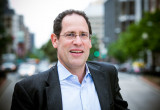
WeMakeThe.City 2019 #1
Bruce Katz: The New Localism
Visiting urbanist Bruce Katz on the power of cities in the age of populism.
According to urban experts Bruce Katz and Jeremy Nowak, power is moving from the national to the local, and from the public to networks of public, private and civic actors. In doing so, 'power now belongs to the problem solvers’, and real change takes place in the communities where most people live and work: cities. In their new book, 'The New Localism', Katz and Nowak describe how these urban players address our most serious social, economic, and environmental challenges - thereby complementing existing top-down systems in times of national dysfunction and growing populism. What other solutions to global challenges can urban communities tackle in the future? And what can the city of Amsterdam learn from these international examples of urban problem solving?
With amongst others
- Bruce Katz, co-founder (with Jeremy Nowak) of New Localism Advisors
- Ger Baron, Chief Technology Officer of the City of Amsterdam
- Maurice Crul, Professor at the Vrije Universiteit Amsterdam and the Erasmus University Rotterdam
Looking for: futuremakers for the “Growing Green Bridges” Hackathon
Heb je ervaring met (circulaire) bouwmaterialen, energie neutrale & eco-positieve innovaties, life cycle analysis, verbinding maken tussen infrastructuur en de omliggende omgeving, water(management) of het onderhoud van bruggen? Kortom: ben jij een ‘bruggenbouwer’?
Op 18 oktober brengen de provincie Flevoland en de gemeente Almere een selecte groep van 100 toekomstmakers bij elkaar om mee te denken over de te ontwerpen en te bouwen innovatieve bruggen voor het nieuw te ontwikkelen Floriade gebied.
AANMELDEN: Meld je vóór 1 oktober aan via: https://goo.gl/forms/QVxBPvEN9qpN4oUx2
ONTMOET inspirerende sprekers over (circulaire) innovatie; neem deel aan interactieve workshops waarin jij gaat brainstormen over, en bouwen aan, jouw ideale Floriade gebied; netwerk met 100 toekomstmakers die zich inzetten voor circulaire infrastructuur, duurzame innovatie en GREEN BRIDGES!
WANNEER: 18 oktober 2018 van 09.00 tot 21.00
WAAR: op een nader te bepalen inspirerende locatie in Almere en omstreken
Deelname is exclusief en gratis.
PARTNERS: Provincie Flevoland & Gemeente Almere
Top 10 Living Labs to check out when visiting Amsterdam
Earlier this summer I was interviewed by Ioana Păunescu for Igloo magazine about what makes Amsterdam so unique as a smart city. Simply said, Amsterdam has always been a laboratory for experiments. Since the Renaissance, citizens have always street-tested new concepts of religion, economics, politics and social justice. Today we are celebrating a new ‘digital’ renaissance where our municipality and communities remain committed to experimentation to develop brand new tools and solutions to make Amsterdam more responsive, resilient and sustainable for its residents and tourists alike.
Before visiting Amsterdam, check out these Top 10 Living Labs to see these experiments first hand.
Want to test your own experiment in Amsterdam? or learn how you can transform your own street or public space into a living lab? contact us at City Exchange Lab - info@citixl.com
Any colour so long as it is black
Today I test drove the Sono Sion, a solar charged EV that comes in “any colour so long as it is black”. Henry Ford implemented this single colour policy for his Model T in 1914, in order to streamline the production process, reduce costs and simply because of the durability of the paint. The similarities between the at the time startup Ford Motor Company and modern time start up Sono Motors go however far beyond beyond colour options.
Henry Ford, an engineer by trade, believed in a strong product market fit. This meant the model T was conceived to be a single, non-configurable product that would satisfy the vast majority of the market. This did not mean the T-Ford was only available in one model, in its production run of almost 20 years (1908-1927) numerous body styles were made that included sedans, coupes, roadsters, pick-ups and delivery vans adding up to a grand production total of 16,5 million model T's. All models were being built with the same technical components on the same platform strategy, allowing for one model for each specific market. Each model however, came in one configuration only.
The Sono Sion comes only in black, not because the owner of the company decided so but because the majority of the online community of Sono Motor followers decided so. When given the choice between black and white for the first production run, the majority of voters elected black. The online community was also asked to choose between two proposals for the front headlight design. This clearly illustrates Sono Motors' strategy to pay very close attention to the best product market fit by actively involving the market in the decision making.
Another example of how Sono Motors is engaging with the market at an early stage is of course the fact that prospects are already invited to test drive one of the two (!) prototypes. Something that is unheard of in the car industry where new cars are developed in secret and car manufacturers camouflage their test vehicles and do everything to hide their precious prototypes from prying eyes.
So how did the actual test drive go? Upon entering the car the first thing that caught my eye was the beautiful transparent polycarbonate roof with solar cells laminated onto the top surface. The sunlight scatters between the cells creating a sparkling mosaic of light and dark. According to Sonos Motors it is unfortunately not sure this feature can be turned over to the final production version because of safety reasons, precisely because of the way the light is being scattered in the car's interior which can be distracting. I guess a tinted roof might be a good way to reduce this effect, because seeing the solar cells on the roof is a very nice design feature and a distinct reminder that you are driving something special. Another reminder is of course the moss in the dashboard that acts like a natural air filter to improve the interior air quality. Other than this I found the car drives like any other electric vehicle on the market today which, keeping in mind that this is still a prototype and development started only 2 years ago, is a big compliment.
It is very clear that the Sion has been made with practicality and affordabilty in mind. That is why it has a (to modern EV standards limited) range of 250 km on a single charge, which should be more than enough to satisfy every day's practical needs. It is compatible with a wide range of charging solutions (household socket, charging station, fast charging) thanks to a wide range of charging connectors and even has a power output (bi-directional charging), which means it can be used as a mobile energy station to charge other electric cars or even a household. The solar panels that are integrated into the bodywork passively charge the car when it is not plugged into an external energy source, while driving for instance. All though solar charging does extend the range, it should be considered as an extra add on and the Sion is primarily conceived to be an affordable, practical electric plug-in vehicle and not a solar car. Even more so, it should foremost be considered a practical family car that seats five persons and has a spacious luggage compartment.
Therefore there is also no budget spilled on making it self driving, instead it comes with built in car sharing (and billing) technology that allows it to be accessed remotely to be driven by other people if the owner is not using it. Payment and reservation are made via the Sono app, which also enables people to hitch a ride as it goes about. Power sharing, car sharing and ride sharing are all part of the Sion's mobility concept that aims to maximize its capacity by making it available to other users. This makes it not only very efficient but also a truly social car.
What I like most about the Sion however is that it's not endlessly configurable, but rather purpose built. In a time where “personalization” of mass products leads to extensive development and marketing costs and thus a higher consumer price, it's a relief to see a mass product that is not trying to please single individuals in the market but rather the market itself. Because after all, what the market wants is a good product at an affordable price. As Henry Ford put it in his memorial My life and work:
“I will build a motor car for the great multitude. It will be large enough for the family but small enough for the individual to run and care for. It will be constructed of the best materials, by the best men to be hired, after the simplest designs that modern engineering can devise. But it will be so low in price that no man making a good salary will be unable to own one – and enjoy with his family the blessing of hours of pleasure in God’s great open spaces.”
Just like the model T was conceived to convert the automobile from an expensive curiosity into an affordable means of personal mass transportation, the Sion aims to make electric mobility more affordable to the general public using the same single product strategy. Today electric cars still have a considerable higher price tag than their fossil fueled competition, but the Sion might just be the car to mass electric mobilize the general public. With a suggested retail price of € 16.000,- excluding tax and a monthly subscription for the battery rent (prices to be announced) or single purchase of the battery pack (€ 4.000,-) Sonos Motors has already received 7329 pre-orders. Not bad for a car with an option list that is limited to a tow bar. I do wish however the mosaic roof (in modern marketing terms) will become available as a second option!
Visit Amsterdam in the travel trivia game Backpacker!

Visit Amsterdam in the travel trivia game Backpacker! Prove your knowledge about the city of Amsterdam and its culture, history, sights, monuments and much more in the travel trivia game Backpacker. You can download the game on the App Store and Google Play by following this link www.backpackergame.com
Explore the world and Amsterdam, become a Backpacker!
Bewonersbijeenkomst | Primeur in Amsterdam Nieuw-West: City-zen Vehicle-to-Grid
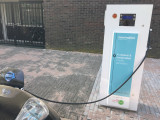
Vehicle-2-grid organiseert een evenement om met buurtbewoners van Amsterdam Nieuw-West in gesprek te gaan over een innovatie die bij hun in de buurt plaats vindt: de Vehicle-to-Grid laadtechnologie. Het innovatieve van dit project is dat een elektrische auto niet alleen opgeladen kan worden, maar ook energie uit de batterij terug kan leveren aan het net. Het idee hierachter is dat de wijk meer duurzaam opgewekte energie zelf kan gebruiken en dat het elektriciteitsnet langer meegaat.
Aanwezig zijn experts van Alliander, NewMotion, Enervalis en de berijders van de elektrische auto’s die deelnemen aan de proef.
Are Smart Cities The Future Of Humanity?
You’ve probably heard about smart cities, but what exactly are they? And what benefits will they provide? We break down everything you need to know.
Digital technology has provided society with hundreds of advances that make life easier and better for everyone. From the personal computer to the internet to the smartphone to the Internet of Things, we are increasingly living in a technologically driven world.
But what if those technologies were bound together and used to build a Smart City?
What would it take to make such a complex network feasible? And what would it look like to live in a such a city?
Are these just the fevered imaginings of science fiction writers or could it be a real possibility? Let’s dig a little deeper.
What Is A Smart City?
First, let’s put aside our Jetsons-inspired ideas of smart cities and look at what they really are.
A smart city contains a framework of Information and Communication Technologies (ICT), specifically designed to answer the overwhelming growth of urban centers.
The ICT framework contains an intelligent network of machines and objects that transmit data wirelessly. These cloud-based applications receive, evaluate and manage data, in real time, to help cities, corporations, and citizens make better decisions that improve quality of life.
Citizens can engage with smart city systems using smartphones and other mobile devices, including cars and homes.
Think the Internet of Things except on a much, much bigger scale. A citywide scale.
Being able to connect to a city’s physical infrastructure and services has the potential to cut costs and improve the city’s sustainability. Cities can improve energy dispersal, streamline city services, decrease traffic and reduce air pollution.
The development of smart cities starts with a digital foundation that allows better functionality, that’s more responsive to citizens, and ultimately creates a better urban environment.
Smart City Technology
Cities are quickly on the move to embrace smart city technology. Autonomous vehicles are already providing data that could create environments where traffic lights become obsolete. Cities can reduce the number of cars as different transportation modes work together and communicate in real time.
Wi-Fi hotspots on a larger scale can transform the way users access information. And, as increased use of public transportation reduces the number of cars on the road, parking needs will decrease and enable cities to repurpose land for housing.
Energy sources could be better integrated into cities, helping to make a cleaner environment for everyone. At the same time, embedded sensors to detect gunshots or explosions will alert emergency services workers much faster. These systems will also find water, electric and gas issues and assign workers to make repairs as soon as they are needed.
All of this possible technological growth is predicated on the idea that technologies can help make people’s lives better in urban areas.
We Proudly Present Our Partners: Part #10 Arcadis
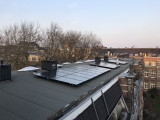
In June we kicked off a new phase of Amsterdam Smart City. More partners than ever are pooling their networks, knowledge and skills. Who are they? We will present some of them one by one. Arcadis: 'The energy supplies we use in the city need to be more decentralized and renewable, without any concessions on reliability.'
What is the main reason for you to join the open collective Amsterdam Smart City?
As an engineering and consultancy firm, Arcadis is always improving and innovating our built environment. As the relation between our built environment and other technologies intensifies, there is also a growing need to collaborate. We want to be part of the ecosystem to create the best, smartest and sustainable city.
What is your ambition for the city and the Amsterdam Metropolitan Area?
Our motto is to improve the quality of life. A smart city for us is a city where all the city systems are optimized to meet the needs of the citizens, to create a city for all people taking profit and planet into account.
What do you think is the biggest challenge for the city and the region in the future?
There is an increasing pressure on all the city systems, e.g. the water system with more drought and heavy rainfall periods, the transition to a climate neutral energy system, or the transportation system with the increasing crowds. Keeping all the city systems flowing and working in a sustainable way is key to ensure quality of life.
How do you see the role of the residents and citizens in your plans?
Residents and citizens, but also people who work in the city or visit the city, are all part of the solution. A city that functions well has the right interaction between the people and the city systems. That requires both people and technology to innovate and develop.
What do you hope to work on in the upcoming years?
The upcoming years will be vital in transforming our society towards a sustainable and healthy one. Energy transition and the transformation of our mobility are the two themes we will focus on within Amsterdam Smart City. The transportation system of the city needs to be transformed to enable more sustainable and more multimodal transport. The energy supplies we use in the city need to be more decentralized and renewable, without any concessions on reliability.
285 solutions!
Sustainable startups in the Netherlands are doing well. Never before has so much been invested in startups that offer solutions to accelerate the energy transition. This is evident from StartupDelta’s bid book Startup Solutions for the Energy Transition, published today containing the profiles of 285 green startups, in partnership with the Postcode Lottery Green Challenge.
Honoured to be featured with WOODYSHOUSING as one of the solutions to drastically reduce CO2 emissions far before 2030!
CO2 reduction is just a beginning. We go further: circular, social, affordable, fair and connecting. We have a very good solution to the deficit in affordable and sustainable housing. We don't do it alone. We believe in cooperation and co-creation with all stakeholders. Thus.... be welcome to contribute in kind or cash, in network or locations to make the impact we aim for individuals and society.
You can be part of WOODYSHOUSING!
SAVE THE DATE – City-zen days from 1 to 3 April 2019 – Amsterdam

Amsterdam invites you to experience the heart of its energy transition from 1-3 April 2019.
We are very happy to announce the dates for the City-zen Days in Amsterdam on 1-3 April 2019! More information to follow; please put these dates in your agenda.
We will be starting to build the programme soon and keep you updated about the program.
If you have any questions, please contact city-zen@amsterdamsmartcity.nl
Sneller melden ("report quickly")

Rembrandt Square is a very popular entertainment area in Amsterdam. But people are also living there, and trying to get some rest. For enforcement, it's difficult to know where the problems are. Together with all parties involved, we created a solution that connects the local residents to enforcement in the streets.
About Tiltshift: https://www.tiltshift.nl/
We Proudly Present Our Partners: Part #9 Waag

In June we kicked off a new phase of Amsterdam Smart City. More partners than ever are pooling their networks, knowledge and skills. Who are they? We will present some of them one by one. Waag: 'Amsterdam should be an innovative frontrunner with a focus on the ethical and principled development of smart city technology.'
What is the main reason for you to join the open collective Amsterdam Smart City?
Waag joined the Amsterdam Smart City collective because we believe that inclusive and open innovation only can happen with cooperation between all stakeholders involved, with an important role reserved for the citizen. Waag represents a critical, but constructive voice in the development of a smart and shared Amsterdam.
What is your ambition for the city and the Amsterdam Metropolitan Area?
Waag wants Amsterdam to be an innovative frontrunner with a special focus on ethical and principled development of new smart city technology. Innovative technology should serve the citizens of Amsterdam. According to the "Amsterdam Approach”, we want to create educated, involved and empowered citizens and involve these citizens in the development of smart city solutions.
What do you think is the biggest challenge for the city and the region in the future?
Waag wants to give back control to the citizens, and give them the tools to manage their environment, personal data and privacy in the development of city of the future.
How do you see the role of the residents and citizens in your plans?
The residents of Amsterdam play an pivotal and essential role in our approach to innovation. Through co-creation, we invite citizens to give input, create, and lend their expertise for the development of open, fair and inclusive technology.
What do you hope to work on in the upcoming years?
In the context of the Smart City Waag is active with several projects on a broad spectrum of topics, such as personal data ownership (DECODE), citizen science (Amsterdam Smart Citizen Lab), maker education (Maakplaats 021), commons (Chamber of Commons), and much more.
Looking for start-ups with awesome mobility concepts
How will smart mobility transform the last mile?
The municipality of Amsterdam, the Vervoerregio and the Province Noord-Holland organize a congress Smart Mobility: Just do it! (Smart Mobility: Gewoon doen) on the 1st of November. We want to inspire guest with new, innovative, smart last mile solutions. A part of the guest will travel by public transport and we want various start-ups to be able to show their products for the last mile. It will be from train station Zaandam to our event location. This is about 2.9 kilometres. It would be ideal if you have a MVP to transport guests from the train station to our event location. You get the opportunity to meet various policy makers regarding (smart) mobility to expose your product and inspire them.
Are you interested? Contact me at s.vermeulen@amsterdam.nl.
Our Future Water Berlin Event
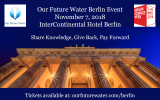
Our Future Water Berlin Event invites all current leaders and future leaders to attend and make water security a reality for today's and future generations.
The event involves an array of over 18 confirmed interdisciplinary European and international speakers, ranging from the Global Water Partnership to the Chief Resilience Officer of Milan, all addressing how we can achieve water security.
The day will be moderated by Karin Helmstaedt, TV host and presenter and one of the most constant faces on Germany's international broadcaster Deutsche Welle.
Our Future Water is a Partner Institution of the BERLIN SCIENCE WEEK. The BERLIN SCIENCE WEEK is an international gathering, bringing together people from the world’s most innovative scientific institutions in Berlin.
Our Future Water has partnered with Connect4Climate, a global partnership program launched by the World Bank and the Italian Ministry of the Environment, together with the German Federal Ministry for Economic Cooperation and Development, that takes on climate change by promoting solutions and empowering people to act.
Last day of Ticket sales September 22nd, 2018: Hotel catering requirements.
We Proudly Present Our Partners: Part #8 University of Applied Sciences

In June we kicked off a new phase of Amsterdam Smart City. More partners than ever are pooling their networks, knowledge and skills. Who are they? We will present some of them one by one. AUAS: 'We will work on knowledge to develop projects that make an impact.'
What is the main reason for you to join the open collective Amsterdam Smart City?
We think the Amsterdam Metropolitan Area is one of the frontrunners in Smart Cities. In this open collective we can achieve two things: work on the development of the area amongst transitions and projects with all relevant stakeholders in the region, whilst at the same time evaluating and reflecting on the Amsterdam approach. This knowledge helps to evaluate different smart city approaches and strategies and helps to make more impact in our collective.
What is your ambition for the city and the Amsterdam Metropolitan Area?
Our ambition is to share knowledge and by doing that, making the region really smart. We will be working on the basis of actual state of the art knowledge and use that to develop projects that make an impact. By conducting applied sciences we test, prove, roll out and evaluate, together with researchers and students. In this way we also prepare our students to make an impact in the region.
What do you think is the biggest challenge for the city and the region in the future?
One of the biggest challenges is the dilemma of stimulating transitions, innovate and speeding up, while at the same time making sure that this is happening in an open, transparent and inclusive way and under the right conditions.
How do you see the role of the residents and citizens in your plans?
Residents are always included in our plans and research. We find it important to get further insights in their needs and motivations, and to find out about new ways of cooperation together with businesses and institutions in the city.
What do you hope to work on in the upcoming years?
We are planning to start and join a couple of bigger (European) research projects on smart city development. And we are developing teaching modules and masterclasses for students and professionals about of smart city projects and their strategies (upscaling, data, business models, democracy by design).
We can change festival
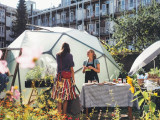
Op zaterdag 22 september organiseert I can change the world with my two hands in Amsterdam West het We can change festival. Op het terrein geven kunstenaars en andere change-makers op een inspirerende manier vorm aan het thema duurzaamheid tijdens workshops en diverse activiteiten.
Zo maak je je eigen op zonne-energie rijdende autootje samen met Designathon Works en ontleed en bereid je ongewenste stadsdieren samen met de Keuken van het Ongewenste Dier. Samen met kunstenaar/florist Denise Collignon van Veld&Vaas maak je een mega oogstslinger van biologische bloemen en andere oogst uit de tuin. Bij Aarde & Co kun je in het Boeren Proef Lab het verschil tussen reguliere en bio-dynamische melk en tomaten proeven. In en rond het I can change Tuinkafe kan je augurken, salsa, honing en ijs van Amsterdamse bodem proeven en kopen.
Hoe tof zou het zijn als in elke buurt binnenterreinen worden benut om de stad gezonder en duurzamer te maken? I can change the world with my two hands werkt aan een blauwdruk. Sinds 2011 kunnen bewoners bij I can change groente, kruiden, bloemen en fruit komen oogsten, tuinieren, keukenresten inleveren voor compost en leren over het gebruik van regenwater. Om 13.30 en om 14.30 uur wordt er een rondleiding gegeven op het terrein. Rainproof en Natuur & MilieuTeam Zuid helpen je op 22 september aan hands-on informatie over het Rainproof maken van je tuin. Agriton en Icanchangers leren je meer over thuis composteren.
De ingang naar het I can change terrein zit op de Jasper Leijnsenstraat 21. Het We can change festival is van 13.00 tot 16.00 uur. Het gehele programma is begin september te vinden op de website: www.icanchangetheworldwithmytwohands.nl
Smart City Tales: free e-book
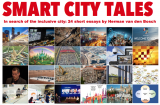
Last year I have written and published 24 short essays that cover the concept smart city from different angles. After modest re-editing, these essays have been grouped in five chapters: Analyses, Examples, Themes, Beyond Smart City and Governance
The English edition (Smart city tales) can be downloaded here:
https://www.dropbox.com/s/c9f1v4od86ibaa3/2018%2007%2030%20Smart%20City%20Tales.pdf?dl=0
The Dutch edition (The smart city idea) can be downloaded here:https://www.dropbox.com/s/k03uilw32un3mp0/2018%2008%2025%20De%20smart%20city%20idee.pdf
Reisproef Amsterdam

Ga het avontuur aan!
We dagen Amsterdammers uit om hun auto en parkeervergunning voor twee maanden in te leveren en te ervaren hoe anders reizen bevalt. In ruil daarvoor krijgen deelnemers een bedrag aan reistegoed bij alle aangesloten vervoerders.
Doe mee met een proef en ruil uw auto twee maanden in voor ander vervoer. Samen houden we de stad bereikbaar en leefbaar.
Meld je hier aan
<https://www.amsterdam.nl/parkeren-verkeer/parkeervergunning/doe-mee-reis>
Lees meer over het smart mobility programma van Amsterdam
<https://www.amsterdam.nl/wonen-leefomgeving/amsterdam-innovatie/smart-mobility/>
Lees hier meer over een eerdere pilot rondom de Zuidas
<https://amsterdamsmartcity.com/projects/maas-in-the-amsterdam-business-district>
Informatie en vragen over de proef
Van welke vervoerders kan ik gebruik maken?
- Openbaar vervoer op basis van de OV-chipkaart
- Taxi: TCA, Uber
- Deelauto: Car2Go, Greenwheels, mywheels
- Huurauto: Tripmanager
- Deelfiets: Urbee
- Scooter: Felyx
- Ridesharing: Viavan
Deze lijst kan nog uitgebreid worden.
Wanneer start de periode van twee maanden? Kan ik zelf kiezen welke maanden ik mee wil doen?
Binnen de looptijd van het experiment bepaalt u zelf de maanden van deelname. Er zijn wel vaste instapmomenten in verband met het inleveren van uw auto.
Waar parkeer ik mijn auto tijdens de proef?
Gedurende de twee maanden van de proef parkeert u uw auto in een gemeentelijke garage. Wij maken de locatie na inschrijving aan de deelnemers bekend.
Moet ik betalen voor mijn vergunning terwijl ik hem niet gebruik?
In de periode dat u meedoet aan de proef levert u uw auto in en kunt u geen gebruik maken van uw parkeervergunning. De kosten van de parkeervergunning in de periode van deelname krijgt u vergoed als aanvulling op uw reiscredits.
Kan ik ook meedoen als ik geen auto heb, of geen parkeervergunning maar wel een auto?
Het experiment is alleen toegankelijk voor mensen in het bezit van een auto + parkeervergunning. Het experiment maakt onderdeel uit van een groter project om Amsterdam autoluw(er) te maken en om het aanbod aan alternatieven voor de auto verder te ontwikkelen.
Kan ik tussendoor mijn auto gebruiken?
Het is niet mogelijk om uw auto tussendoor te gebruiken. Is er sprake van nood dan bekijkt het projectteam per geval of u de auto terug kunt krijgen.
Stay up to date
Get notified about new updates, opportunities or events that match your interests.

